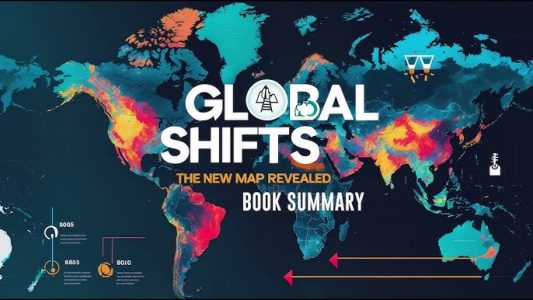The world map, once defined by familiar lines of power and predictable alliances, is being redrawn before our eyes. Not by wars or colonial borders this time—but by strategy, economics, and technology. The post–Cold War consensus that shaped global politics for three decades is eroding, giving way to a multipolar reality where influence is shared, challenged, and negotiated daily. From Washington to Beijing, from New Delhi to Riyadh, nations are forging new partnerships and reviving old rivalries in a high-stakes game of global repositioning.
The End of the Unipolar Era
For years after the fall of the Soviet Union, the United States stood unchallenged as the world’s dominant superpower. The “unipolar moment,” as it was called, seemed permanent—until now. The rise of China, the reassertion of Russia, and the growing assertiveness of middle powers like India, Brazil, and Turkey are tilting the balance.
China’s Belt and Road Initiative (BRI) has evolved into one of the most ambitious geopolitical projects in history, extending Beijing’s reach across Asia, Africa, and Europe through infrastructure and investment. Russia, despite economic sanctions and global isolation, has leveraged its energy resources and military clout to maintain relevance. Meanwhile, Washington’s decades-old network of alliances—from NATO in Europe to strategic partnerships in Asia—is being tested by shifting loyalties and emerging powers that refuse to play by old rules.
The result? A world where influence no longer flows from a single center of power but from multiple competing hubs—each pursuing its own vision of order.
Asia at the Center of Gravity
If the 20th century belonged to the Atlantic, the 21st undoubtedly belongs to the Indo-Pacific. Asia’s economic dynamism, military expansion, and technological innovation have made it the new epicenter of global strategy.
China’s assertive foreign policy in the South China Sea and its economic dominance across Asia have triggered counterbalances. Japan and South Korea, once restrained in their defense postures, are strengthening military capabilities. India, long non-aligned, has emerged as a decisive player—joining the Quad alliance with the U.S., Japan, and Australia to counter China’s influence.
At the same time, Southeast Asian nations are maneuvering delicately, hedging their bets between Beijing’s economic incentives and Washington’s security guarantees. It’s a careful dance of pragmatism and survival—a hallmark of the new age of fluid alliances.
The Middle East: A Region Rewriting Its Playbook
Perhaps nowhere are the tectonic shifts in global alliances more visible than in the Middle East. For decades, the region’s politics revolved around American military dominance, oil economics, and the Arab-Israeli divide. But the landscape is changing fast.
The Abraham Accords normalized relations between Israel and several Arab states, reshaping decades of diplomatic hostility. Saudi Arabia’s pivot toward economic diversification and its cautious engagement with both China and Iran underscore a new strategic independence from Washington. Meanwhile, Iran has deepened its ties with Russia and China, leveraging its energy resources and geopolitical leverage to remain relevant despite Western sanctions.
The United States, though still influential, no longer dictates the terms in the Middle East—it negotiates them. Power in the region now flows through multiple channels: trade, technology, and diplomacy as much as through arms.
Europe’s Awakening: Unity Under Pressure
Europe’s alliances, too, are undergoing a transformation born out of necessity. Russia’s invasion of Ukraine shattered illusions of perpetual peace and forced the European Union to confront its vulnerabilities—energy dependence, defense readiness, and political cohesion.
NATO, once described as “brain dead,” has found new purpose. Finland and Sweden’s historic bids to join the alliance marked a dramatic break from neutrality. The European Union, meanwhile, has moved toward strategic autonomy, seeking to reduce reliance on both American protection and Chinese manufacturing.
As Europe redefines its collective identity, it faces the difficult balance between transatlantic solidarity and continental independence. The war in Ukraine may have revived NATO, but it also accelerated Europe’s desire to stand on its own feet—a subtle but profound geopolitical evolution.
Africa and Latin America: The New Frontiers of Influence
While the spotlight often shines on major powers, the quieter story of the century is unfolding across Africa and Latin America. These regions—long seen as peripheries—are now strategic battlegrounds for global influence.
China’s investments in African infrastructure, from railways to ports, have transformed it into the continent’s leading economic partner. The United States, European Union, and even Russia have scrambled to re-engage, not out of altruism, but competition. Africa’s vast mineral wealth, young population, and growing digital economy make it the next frontier for both opportunity and rivalry.
In Latin America, the political pendulum is swinging again. Nations like Brazil and Mexico are asserting greater regional leadership while carefully managing relations with Washington and Beijing. The revival of regional blocs and left-leaning governments hints at a return to strategic autonomy—one less dependent on U.S. influence and more open to multipolar engagement.
Technology: The New Battleground
Beyond geography, technology has become the new axis of power. Nations no longer compete solely through armies or trade routes but through chips, code, and data.
The battle over semiconductor dominance, the race for artificial intelligence supremacy, and the contest for 5G and 6G infrastructure have blurred the line between economics and national security. The U.S. has imposed sweeping export bans to limit China’s access to advanced chips. In response, Beijing is pouring billions into homegrown innovation. Meanwhile, Europe and India are racing to develop independent tech ecosystems to reduce dependency on foreign giants.
Technology, once the great equalizer, has become a tool of strategic leverage—a new form of diplomacy that rewards innovation as much as it does influence.
The Rise of the “Middle Powers”
In this new world order, not all power belongs to superpowers. Middle powers—nations like South Korea, Turkey, Saudi Arabia, Australia, and Indonesia—are increasingly shaping global outcomes through niche diplomacy and regional leadership.
These countries are neither followers nor mere observers; they are agenda-setters in their own right. They mediate conflicts, forge trade blocs, and pioneer renewable energy and technology partnerships. Their growing role signals a shift from bipolar or even tripolar worldviews to a web of interconnected, interdependent relationships.
A World in Flux
The world is not fragmenting—it’s realigning. The alliances being forged today are fluid, transactional, and often pragmatic. Ideology has given way to interest; friendship to convenience. What binds nations now is not shared values, but shared needs: energy security, technological resilience, and economic survival.
This era of global shifts is both exhilarating and unsettling. Old certainties are dissolving, but new possibilities are emerging. The challenge for world leaders is to navigate this complexity without igniting conflict—to build a new equilibrium in an age where power is everywhere, and loyalty is nowhere permanent.
The Map Keeps Moving
In the 20th century, maps were redrawn through wars. In the 21st, they’re being redrawn through partnerships, trade routes, and digital connections. The boundaries of influence are now measured not just in territory, but in technology, alliances, and access to resources.
The question that will define this century is not who rules the world, but how the world will be ruled—through competition or cooperation, isolation or integration. One thing is certain: the map is moving again, and this time, everyone’s pen is on it.



